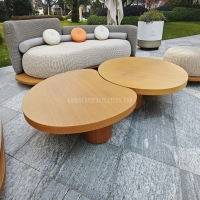Welcome to the website for landscape facilities products and knowledge.
How does the table’s design account for uneven ground or surfaces in outdoor settings?
When enjoying a meal or drinks outdoors, few things are more frustrating than a wobbly table. Modern outdoor table design has evolved sophisticated solutions to combat the challenges of uneven terrain, ensuring stable surfaces regardless of the ground beneath.
The most common innovation comes in the form of adjustable legs. Many premium outdoor tables feature threaded leg extensions or built-in leveling mechanisms that can be raised or lowered individually. This allows users to compensate for slopes or irregular surfaces by making micro-adjustments until the table sits perfectly level. Some designs incorporate rotating feet with rubberized bottoms that conform to ground contours while providing enhanced grip.
Material selection plays a crucial role in outdoor table stability. Manufacturers often use slightly flexible materials like certain weather-resistant polymers or specially treated woods that can absorb minor ground inconsistencies without compromising structural integrity. These materials have enough give to accommodate small variations while maintaining overall stability.
Strategic weight distribution represents another clever approach. Designers intentionally position weight toward the table's center or lower the center of gravity through heavier base materials. This prevents the table from becoming top-heavy and reduces the likelihood of tipping or rocking, even when placed on sloped surfaces.
Some innovative designs feature articulated bases or segmented foot systems that pivot independently. These multi-point contact systems automatically adjust to ground contours, much like a tripod stabilizes on uneven terrain. The result is consistent stability without requiring manual adjustments from the user.
For permanent outdoor installations, some tables incorporate ground-anchoring systems. These might include recessed holes for stakes or integrated hardware that secures directly to patio surfaces. While less common for movable furniture, this approach provides absolute stability in windy conditions or on significant slopes.
Beyond mechanical solutions, designers also employ visual tricks to minimize the appearance of instability. Tapered legs, strategic color blocking, and patterned surfaces can make slight angles less noticeable to the eye, enhancing the perception of stability even when perfect levelness isn't achievable.
The evolution of outdoor table design demonstrates how furniture engineering has adapted to real-world conditions. Through adjustable components, smart material choices, and innovative structural approaches, today's outdoor tables deliver reliable performance across the varied landscapes of gardens, patios, and natural outdoor settings.
Related search:

Recommendation
Elliptical metal outdoor table with nested design, resembling wood grain, round table